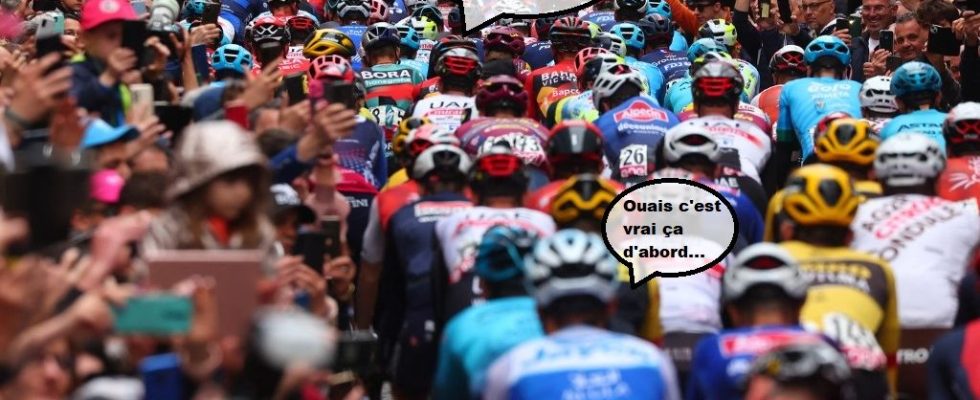We had almost forgotten it, by dint of freedoms found in our daily lives and sports competitions disputed without apparent constraint, but the Covid is still very present and continues to rot the lives of some. It may be that we didn’t want to look at it too closely either, but the mishap that happened to Remco Evenepoel on Sunday in the Giro d’Italia reminds us: the coronavirus remains a sneaky enemy, capable of destroying in a fraction second the major objective of the season of one of the greatest talents in the world. At least in cycling.
When the vast majority of sports only see it as a distant (bad) memory, the world of cycling, particularly vulnerable, retains a special relationship with this virus. Nothing forces teams to exfiltrate their riders after a positive test. The concept of a health bubble and the drastic protocols to preserve it officially no longer exist since January 1 of this year. However, the Soudal-Quick-Step did not hesitate long to send home its leader, world champion and big favorite of the Giro. On his own command. A decision that may surprise… if you are outside the bike.
Runner infected = danger
“We know today, with a little hindsight, that the Covid can have a strong impact on runners, in terms of health and performance, with cardiac and pulmonary repercussions, explains Serge Niamke, the medical manager of the AG2R Citroën team. It is important for us, despite the sporting disappointment represented by a retirement, to focus on the preservation of the health of the runner before the result. This was the meaning of Belgian team boss Patrick Lefevere’s brief comment on Sunday evening about his foal: “zero risk”.
Beyond the fact of living together 24 hours a day during a race, with the closeness that this induces, cycling is an eminently violent endurance sport, especially on the Grand Tours where you have to ride between four and six hours. per day for three weeks, sometimes with temperature variations that weaken the immune system. The body is stressed to the extreme and in an uninterrupted way, in particular the respiratory tract. Rolling an infected rider, even asymptomatic or with a fairly low viral load, could be dangerous.
Long term risks
“There are no more regulations but it is medical common sense, observes the head of the health sector of Groupama-FDJ Jacky Maillot. We are never safe from a serious form which would lead to complications, and then anyway we know that it will not be efficient. We had positive riders before the Tour de France last year, they only regained their form after one or two months. If Evenepoel had continued, he would have exhausted himself. »
A certain consensus has emerged lately among the doctors of the World Tour teams not to tempt fate in the event of a positive test. “You have to put the runner to rest. It is the only effective treatment for viral pathologies because it is the only one that allows the body to keep all its energy to recover completely, continues Serge Niamke. Failure to do so exposes the runner to non-performance for several months after infection. »
We then understand why cyclists continue to track down the little beast. They are among the few athletes that we still see with masks, and above all who still speak of the Covid as a reality. Remco Evenepoel himself was well aware of this before the start of the Giro. “You have to be very careful,” he said in an article by La Repubblica released in early May. Wearing a mask, washing your hands and avoiding unnecessary contact will be important over the next three weeks. If the journalists want to see me on Saturday, they will have to wear a mask. »
Prophetic, unfortunately for him. That’s the whole difficulty of it, staying away from a virus in as porous an environment as possible. We are not going to ask the public to wear masks on the side of the roads, so it is up to the athletes to adapt. “We maintain the barrier gestures within the team to protect ourselves as best we can, runners and staff: masks at the end of the stages, hand washing, etc., explains Serge Niamke. But there will always be holes in the racket, contamination in transport, hotels, etc. »
“Not immune to other viruses in the years to come”
On the side of Groupama-FDJ, old habits are well anchored. A person is in charge of arriving at the hotel a few hours before the runners to disinfect the air conditioning units, door handles and anything else that may come into their hands. The team bus is also thoroughly cleaned every evening. That doesn’t prevent minor colds, as Thibaut Pinot experienced at the end of last week, but on Monday the whole team passed the routine test established on each rest day without incident.
If the protocols are on the whole a little lighter than during the last two seasons (“we can’t cut ourselves off from everyone all the time, it was heavy for the riders, the staff, the sponsors who want to come share the life of the team”, explains Jacky Maillot), caution remains the watchword. And that’s not about to change. “Given what we are announcing on global warming, we are not immune to other viruses in the years to come so we will have to continue to live with that”, projects the doctor from Groupama-FDJ.
In the meantime, the director of the Tour of Italy Mauro Vegni announced on Monday the return of a health protocol after the contamination of five other riders since the start, in addition to Evenepoel. “We dropped the focus a little too soon. We must continue to remain vigilant,” he told the Gazzetta dello Sport. From this Tuesday, wearing a mask will again be compulsory in the contact areas with the runners, at the start and at the finish. »

